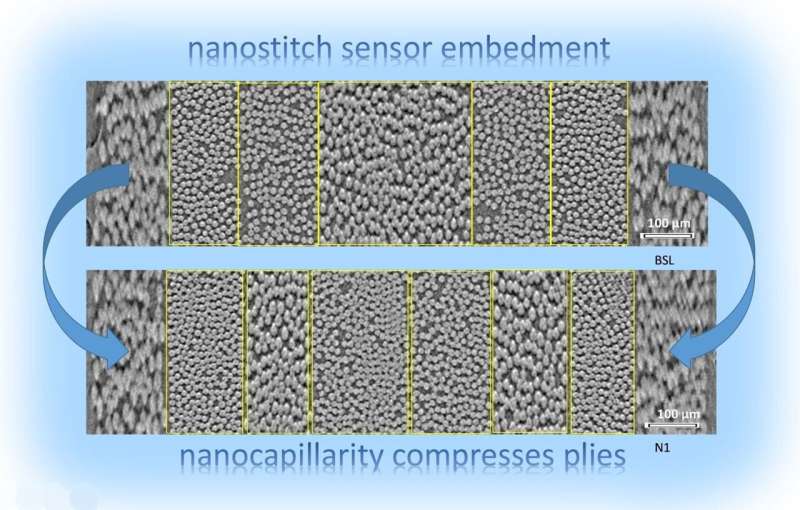
A nanostructured sensor, whose development and tests involved Skoltech researchers, has shown promise for enhancing construction parts made of glass fiber-reinforced polymer composite materials: aircraft wings, wind turbine blades, bridge spans, car bodies, boat hulls, etc. It can be embedded into a structure without the need to cure it in an autoclave.
Made of carbon nanotubes, it generates heat under electrical current; when embedded, it leaves the composite’s thickness unaffected, other characteristics unimpaired and does not create undesirable pores. It can serve as a sensor for structural health monitoring or a heater for anti-icing or de-icing purposes.
The latter is especially important for shipbuilding and small aviation, where fiberglass structures are abundant, particularly as regards the program of Arctic land development. The study was published in Polymers.
“The results of our research are remarkable for several reasons,” one of the investigators of the study, Leading Research Scientist Sergey Abaimov of Skoltech, commented.
“For one thing, the composite is endowed with extra functionality: By applying an electrical current to the carbon nanotube layer and monitoring the signal, it is possible to keep track of the structure’s deterioration and avert disaster by anticipating breakage. Electricity can also be used for heating, for example, to de-ice an aircraft wing or a wind turbine blade. Secondly, the heating can be used to manufacture this material in the first place, ‘self-curing’ the polymer composite without using an autoclave, which is costly and power-hungry.”
“Moreover, and this is what the paper in Polymers is about, we are also addressing the problem that plagues materials with embedded microstructures in general: the adverse effects of embedment on composite properties,” the lead author of the study, Skoltech’s Stepan Lomov, added.
“One would expect that once we embed carbon nanotubes—or anything, really—into a composite, we have to put up with increased thickness and additional defects in the form of pores or distorted fiber orientation. But surprisingly, we end up with unchanged thickness, no added porosity, and the mechanical properties are improved, not compromised.”
Glass fiber-reinforced polymer composite materials are used in aircraft, ships, bridges, cars, sports equipment, and elsewhere. They are produced by curing together many layers of glass fiber plies impregnated by epoxy resin. To produce a high-quality composite, the entire composite part—which might be huge, for example, in aircraft engineering—is cured in a high-temperature, high-pressure chamber called an autoclave.
Only major companies can afford an autoclave big enough to manufacture large parts with this technology, and the electricity costs and environmental impact are also a concern, because much power is consumed to heat up the entire volume of the chamber every time, regardless of the actual size and shape of the composite part being cured.
“If you embed carbon nanotubes between the adjacent layers of the composite, however, you can apply an electrical current and very efficiently deliver heat into the material without wasting energy on heating the entire volume of the autoclave. This could conserve something like 99% of the power,” Abaimov said.
To compare materials’ characteristics, the team manufactured the polymer composite both without the embedded carbon nanotube structure and with it. Measurements revealed neither increase in thickness, nor unwanted pore formation, nor fiber misalignment.
The researchers explained this in terms of the nanotubes’ extremely high nanocapillarity, a property that causes them to “suck out” the pores from the epoxy resin, which would otherwise adversely affect the composite’s characteristics, generating pressure that causes the glass fiber layers to stick firmly together.
The study reported in this story belongs to a field of research that the authors themselves refer to as “multifunctional fusion for life-cycle enhancement of materials via nanoengineering of advanced composite structures.”
In other words, the proposed nanostructure enhances the properties of the material and endows it with multiple functionality—in this case, structural health monitoring and de-icing—as well as playing an active role at various stages of product’s life cycle, as early as its manufacture, when the conductive carbon nanotube layer enables out-of-autoclave curing of the composite.
Together with Skoltech Ph.D. student Alexei Shiverskii, Sergey Abaimov created a unique reactor for manufacturing nanocomposite structures at the Institute. “The paper we published this time is merely the first step on the way to implementing the wide range of functionalities that we claim to exist,” Abaimov explained. “Next, we need to get down to work and achieve results for all claimed functionalities, which should be of interest outside the lab, in the industries concerned.”
More information:
Stepan V. Lomov et al, Influence of the Nanostitch Sensor Embedment on the Fibrous Microstructure of Glass Fiber Prepreg Laminates, Polymers (2022). DOI: 10.3390/polym14214644
Provided by
Skolkovo Institute of Science and Technology

READ MORE
Signature approach reveals prized property in nanoscopic material
A rendering of a nanoscopically thin polymer (semitransparent blue) atop a semiconductor known as rhenium [...]
Picture of the Week: A Deep View of the Universe
A selection of a new image of distant galaxies in the COSMOS field. Click to [...]
Bacteria-sized robots take on microplastics and win by breaking them down
Metallic microrobots (dark blue dots) colonize a jagged piece of microplastic under visible light, breaking [...]
Life in the Cosmos
The Search for Life SMART NEWS See the Messages NASA Will Send to Space on [...]
Mining for Meteorites
It was the morning of June 13, 1998, when a 4.6-billion-year-old extraterrestrial object passed the [...]
Hundreds of emperor penguin chicks spotted plunging off a 50-foot cliff in 1st-of-its-kind footage
The fledglings are typically reared on floating platforms of sea ice, but an unprecedented decline [...]
Researchers use tiny diamonds to create intracellular sensors
Schematic of the optical setup used for optical trapping (a) with an image of the [...]
How to Remove Paint from Metal
If you’re looking to repaint your metal hardware or furniture or you’re trying to clean [...]